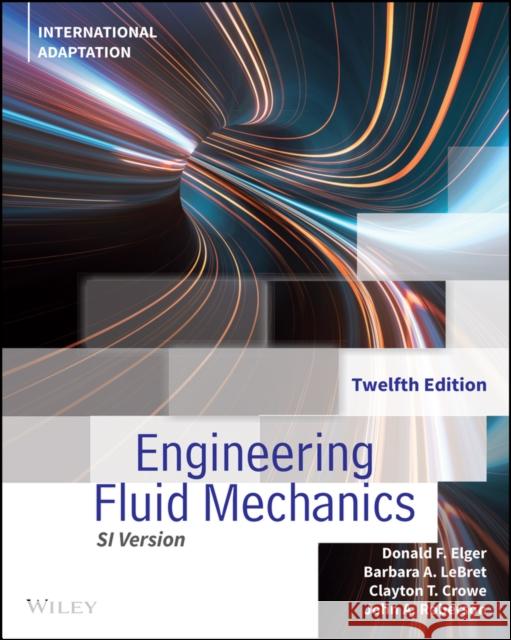Engineering Fluid Mechanics » książka



Engineering Fluid Mechanics
ISBN-13: 9781119820734 / Angielski / Miękka / 2022 / 624 str.
Engineering Fluid Mechanics
ISBN-13: 9781119820734 / Angielski / Miękka / 2022 / 624 str.
(netto: 262,39 VAT: 5%)
Najniższa cena z 30 dni: 250,44
ok. 30 dni roboczych
Bez gwarancji dostawy przed świętami
Darmowa dostawa!
1. Introduction1.1 Engineering Fluid Mechanics1.2 Modeling in Fluid Mechanics and Engineering1.3 Modeling of Materials1.4 Weight, Mass, and Newton's Law of Gravitation1.5 Essential Mathematics Topics1.6 Density and Specific Weight1.7 The Ideal Gas Law (IGL)1.8 Quantity, Units, and Dimensions1.9 Problem Solving1.10 Summarizing Key KnowledgeProblems2. Fluid Properties2.1 System, State, and Property2.2 Looking Up Fluid Properties2.3 Specific Gravity, Constant Density, and the Bulk Modulus2.4 Pressure and Shear Stress2.5 The Viscosity Equation2.6 Surface Tension and Capillary Action2.7 Vapor Pressure, Boiling, and Cavitation2.8 Characterizing Thermal Energy in Flowing Gases2.9 Summarizing Key KnowledgeProblems3. Fluid Statics3.1 Describing Pressure3.2 The Hydrostatic Equations3.3 Measurement of Pressure3.4 The Pressure Force on a Panel (Flat Surface)3.5 Calculating the Pressure Force on a Curved Surface3.6 Calculating Buoyant Forces3.7 Predicting Stability of Immersed and Floating Bodies3.8 Summarizing Key KnowledgeProblems4. Bernoulli Equation and Pressure Variation4.1 Flow Patterns: Streamlines, Streaklines, and Pathlines4.2 Characterizing Velocity of a Flowing Fluid4.3 Describing Flow4.4 Acceleration4.5 Applying Euler's Equation to Understand Pressure Variation4.6 The Bernoulli Equation along a Streamline4.7 Measuring Velocity and Pressure4.8 Characterizing the Rotational Motion of a Flowing Fluid4.9 The Bernoulli Equation for Irrotational Flow4.10 Describing the Pressure Field for Flow over a Circular Cylinder4.10 Elementary Plane potential Flows4.11 Calculating the Pressure Field for a Rotating Flow4.12 Summarizing Key KnowledgeProblems5. The Control Volume Approach and The Continuity Equation5.1 Characterizing the Rate of Flow5.2 The Control Volume Approach5.3 The Continuity Equation (Theory)5.4 The Continuity Equation (Application)5.5 Predicting Cavitation5.6 Summarizing Key Knowledge6. The Momentum Equation6.1 Understanding Newton's Second Law of Motion6.2 The Linear Momentum Equation: Theory6.3 The Linear Momentum Equation: Application6.4 The Linear Momentum Equation for a Stationary Control Volume6.5 Examples of the Linear Momentum Equation (Moving Objects)6.6 The Angular Momentum Equation6.7 Summarizing Key KnowledgeProblems7. The Energy Equation7.1 Technical Vocabulary: Work, Energy, and Power7.2 Conservation of Energy7.3 The Energy Equation7.4 The Power Equation7.5 Mechanical Efficiency7.6 Contrasting the Bernoulli Equation and the Energy Equation7.7 Transitions7.8 The Hydraulic and Energy Grade Lines7.9 Summarizing Key KnowledgeProblems8. Dimensional Analysis and Similitude8.1 The Need for Dimensional Analysis8.2 Buckingham n-ary product Theorem8.3 Dimensional Analysis8.4 Common pi-Groups8.5 Similitude8.6 Model Studies for Flows without Free-Surface Effects8.7 Model-Prototype Performance8.8 Approximate Similitude at High Reynolds Numbers8.9 Free-Surface Model Studies8.10 Summarizing Key KnowledgeProblems9. Viscous Flow Over a Flat Surface, Drag and Lift9.1 The Navier-Stokes Equation for Uniform Flow9.2 Couette Flow9.3 Poiseuille Flow in a Channel9.4 The Boundary Layer (Description)9.5 Velocity Profiles in the Boundary Layer9.6 The Boundary Layer (Calculations)9.7 Relating Lift and Drag to Stress Distributions9.8 Calculating the Drag Force9.9 Drag of Axisymmetric and 3-D Bodies9.10 Terminal Velocity9.11 Vortex Shedding9.12 Reducing Drag by Streamlining9.13 Drag in Compressible Flow9.14 The Theory of Lift9.15 Lift and Drag on Airfoils9.16 Lift and Drag on Road Vehicles9.17 Summarizing Key KnowledgeProblems10. Flow in Conduits10.1 Classifying Flow10.2 Specifying Pipe Sizes10.3 Pipe Head Loss (Major and Minor losses)10.4 Stress Distributions in Pipe Flow10.5 Laminar Flow in a Circular Pipe10.6 Turbulent Flow and the Moody Chart10.7 A Strategy for Solving Problems10.8 Combined Head Loss10.9 Noncircular Conduits10.10 Pumps and Systems of Pipes10.11 Summarizing Key KnowledgeProblems11. Compressible Flow11.1 Wave Propagation in Compressible Fluids11.2 Mach Number Relationships11.3 Normal Shock Waves11.4 Isentropic Compressible Flow through a Duct with Varying Area11.5 Summarizing Key KnowledgeProblems12. Flow Measurements12.1 Measuring Velocity and Pressure12.2 Measuring Flow Rate (Discharge)12.3 Summarizing Key KnowledgeProblems13.Turbomachinery13.1 Propellers13.2 Axial-Flow Pumps13.3 Radial-Flow Machines13.4 Specific Speed13.5 Suction Limitations of Pumps13.6 Viscous Effects13.7 Centrifugal Compressors13.8 Positive Displacement Pumps13.9 Turbines13.10 Summarizing Key KnowledgeProblems14. Flow in Open Channels14.1 Describing Open-Channel Flow14.2 Energy Equation for Steady Open-Channel Flow14.3 Steady Uniform Flow14.4 Steady Nonuniform Flow14.5 Rapidly Varied Flow14.6 Hydraulic Jump14.7 Gradually Varied Flow14.8 Summarizing Key KnowledgeProblems15. Modeling of Fluid Dynamics Problems15.1 Models in Fluid Mechanics15.2 Foundations for Learning Partial Differential Equations (PDEs)15.3 The Continuity Equation15.4 The Navier-Stokes Equation15.5 Computational Fluid Dynamics (CFD)15.6 Examples of CFD15.7 A Path for Moving Forward15.8 Summarizing Key KnowledgeProblemsAppendixAnswersIndex
1997-2025 DolnySlask.com Agencja Internetowa
KrainaKsiazek.PL - Księgarnia Internetowa









